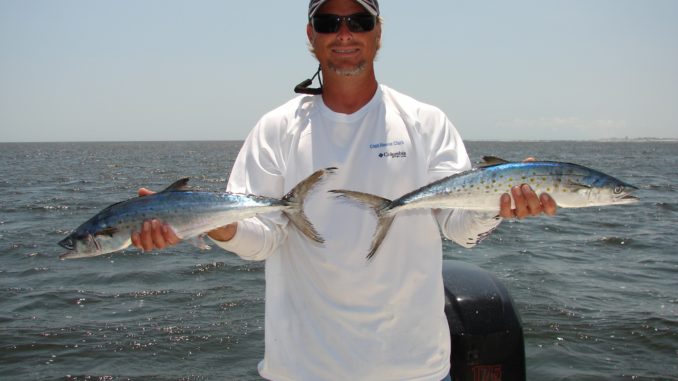
Mackerel will be full force in SE waters this month
Spanish mackerel are favorites of many North Carolina fishermen, especially along the southern coast. Their popularity is based on four undeniable traits:
• They are around in good numbers;
• They are willing biters;
• They can usually be found just outside inlets;
• They taste good.
Spanish mackerel are one of the first fish to arrive along southern beaches each year. They move up the coach following pods of baitfish and usually arrive during May, but they’re here in full force by June.
Spanish mackerel are usually hungry and feeding, so when you find them, they are usually biting. Some of the best spots to find Spanish are around the tide lines just outside the inlets. On every falling tide, Masonboro, Carolina Beach, Cape Fear River, Lockwood Folly, Shallotte and Little River inlets have tide lines form as the dirtier inside water pushes back against the cleaner ocean water. The color changes on most of these tide lines is so distinct they doesn’t require polarized sunglasses to see. The river water is brown, the ocean water is green, and the hard color change is where they meet.
Most of the southern coast has a tide change of at least 4 feet, and a lot of water flows back and forth through the inlets. This water carries a lot of baitfish and shrimp, and the hungry fish know it. On the full and new moon, the tides are exaggerated, and the tide lines push across artificial reefs near the inlets. Spanish fishing is usually good during June, and sometimes, it is exceptional.
Spanish typically aren’t difficult to locate, usually on the tide lines or around nearshore artificial reefs. Sometimes they can be seen chasing bait, and sometimes flocks of seagulls diving over them give away their location.
The standard for catching Spanish mackerel is trolling Nos. 00 and 0 Clark Spoons on long, monofilament leaders behind trolling sinkers or small planers. Vary the weight of the sinkers or size of the planers to reach different depths and find where they are feeding. The best trolling speed is 6 to 8 knots.
For more fun, use light spinning gear and cast small Got-Cha jigs or Jigfish lures to the schools of bait or breaking Spanish and retrieve them briskly. With Got-Chas, gold hooks are imperative. Jigfish will usually catch Spanish without gold hooks, but they catch even better with gold hooks; you’ll have to buy and switch them. It will be well worth it as tasty Spanish mackerels\ fill your cooler.




Be the first to comment